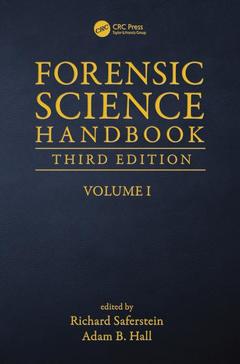L’édition demandée n’est plus disponible, nous vous proposons la dernière édition.
Forensic Science Handbook, Volume I (3rd Ed.)

Originally published in 1982 by Pearson/Prentice-Hall, the Forensic Science Handbook, Third Edition has been fully updated and revised to include the latest developments in scientific testing, analysis, and interpretation of forensic evidence. World-renowned forensic scientist, author, and educator Dr. Richard Saferstein once again brings together a contributor list that is a veritable Who?s Who of the top forensic scientists in the field. This Third Edition, he is joined by co-editor Dr. Adam Hall, a forensic scientist and Assistant Professor within the Biomedical Forensic Sciences Program at Boston University School of Medicine. This two-volume series focuses on the legal, evidentiary, biological, and chemical aspects of forensic science practice.
The topics covered in this new edition of Volume I include a broad range of subjects including:
? Legal aspects of forensic science
? Analytical instrumentation to include: microspectrophotometry, infrared Spectroscopy, gas chromatography, liquid chromatography, capillary electrophoresis, and mass spectrometry
? Trace evidence characterization of hairs, dust, paints and inks
? Identification of body fluids and human DNA
This is an update of a classic reference series and will serve as a must-have desk reference for forensic science practitioners. It will likewise be a welcome resource for professors teaching advanced forensic science techniques and methodologies at universities world-wide, particularly at the graduate level.
1. Legal Aspects of Forensic Science
[Gil I. Sapir]
2. Forensic Paint Examination
[Diana Wright, Daniel Kirby, and John Thornton]
3. The Forensic Identification and Association of Human Hair
[Richard E. Bisbing]
4. A Guide to the Analysis of Forensic Household Dust Specimens and Their Statistical Significance
[Nicholas Petraco and Nicholas D. K. Petraco]
5. Fundamentals of Visible Microspectrophotometry in Forensic Science
[Michael B. Eyring]
6. Infrared Spectroscopy in the Forensic Sciences
[Edward M. Suzuki]
7. Forensic Characterization and Comparisons of Inks
[Tatiana Trejos and Jose Almirall]
8. Forensic Gas Chromatography
[Thomas A. Brettell and David T. Stafford]
9. Forensic Applications of High Performance Liquid Chromatography and Capillary Electrophoresis
[David Northrup]
10. Forensic Mass Spectrometry
[Adam B. Hall and Richard Saferstein]
11. Analysis of Body Fluids in Sexual Assault Cases
[Edwin Jones]
12. The Application of Capillary Electrophoresis in Forensic DNA Analysis
[Bruce McCord]
Dr. Richard Saferstein headed the crime laboratory of the New Jersey State Police from 1970 to 1991. Dr. Saferstein served as an expert witness over 2000 times in nearly 150 federal and state courts involving a variety of forensic issues. His areas of expertise encompassed breath and blood testing for alcohol, pharmacological effects of alcohol and drugs, detection and identification of drugs in biological fluids, fire debris analysis, the forensic examination of blood, semen, hair, paint, fiber, and glass as well as the review and evaluation of forensic DNA evidence. Dr. Saferstein was a prolific writer who authored numerous papers and had five books published by Prentice-Hall. His name can be found in the membership rolls of numerous professional organizations, which reflect his broad range of professional interests. Dr. Saferstein was a Fellow of the American Academy of Forensic Sciences. In 1970 Richard earned a PhD in Chemistry from the City University of New York (CUNY).
Dr. Adam B. Hall is an Assistant Professor within the Biomedical Forensic Sciences Program, Department of Anatomy and Neurobiology at Boston University School of Medicine where he instructs and mentors graduate students in various areas of foren-sic chemistry and instrumental analysis. Dr. Hall is also the Associate Director of the Center for Advanced Research in Forensic Science (CARFS), a jointly supported NSF and NIJ Industry/University Cooperative Research Center (I/UCRC) in Forensic Science. His career has taken him from the crime scene to the crime lab as a forensic chem-ist with the Massachusetts State Police Crime Laboratory and now the academic lab. Previously, he was the Director of the Mass Spectrometry Facility at the Barnett Institute of Chemical and Biological Analysis, and a Lecturer within the Department of Chemistry and Chemical Biology at Northeastern University in Boston, Massachusetts. He earned a Bachelor’s degree in Chemistry fr
Date de parution : 10-2020
17.8x25.4 cm
Thèmes de Forensic Science Handbook, Volume I :
Mots-clés :
Sample Preparation; Ignitable Liquids; analytical chemistry; Forensic DNA Analysis; forensic science; Mobile Phase; forensic chemistry; WCOT Column; drug analysis; chemical analysis; Fire Debris; crime lab; Raman Spectroscopy; Input DNA; Ft IR Instrument; Dart Ionization; Str Locus; Infrared Microscope; Ft IR Spectrometer; Str Kit; Allele Dropout; Microscopical Hair Comparison; Reagent Gas Ion; Reagent Gas; ATR Spectrum; ATR Analysis; Inkjet Inks; Architectural Paints; Hair Comparison; Stochastic Threshold



